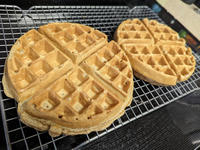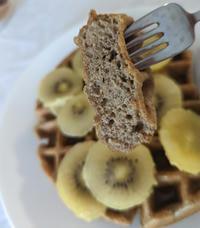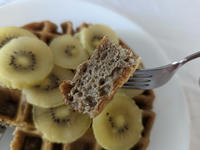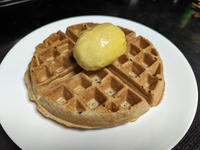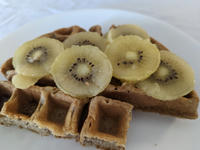Weekend Lunch for Two
A New Breed🔗
As we all know, you can pretty much mix sourdough starter into any batter and yield an interesting variation. The benefits of using natural yeast are i) more complex flavor from the sour tangy notes and ii) better texture from yeast leavening effect. So this week I decided to give our yeasty boy a go at pancake batter. Of course it's cooked in waffle iron (another episode about how we changed our weekend pancake from pan to waffle iron). But I still prefer to call it pancake batter.
I'd normally use sourdough starter in pancake batter regardless. But only mix it in with all the other ingredients right before cooking. To really let sourdough release its power, you gotta prepare poolish, aka pre-ferment, aka starter + flour + water, ahead of time so that the slow fermentation can take place. So here is what I did. On Saturday, I prepared the batter as normal, i.e. mixing everything right before cooking. Right after cooking in the same mixing bowl, I mixed yeasty boy, flour and coconut milk as the poolish. On Sunday right before cooking, I added the rest of the ingredients. This way we get to compare the final results from the two methods and judge if it's worth the effort to take the extra step of making poolish ahead.
I will give the measurements for the two methods below for reference. Though I usually don't stick with the number as it largely depends on the hydration level of the starter. Depending on how it's last fed, hydration level is gonna vary every time. That being said, you need to adjust according to your starter's condition. If the starter is stiff, use more water and/or less flour. It's all about getting the batter into a certain consistency. For the overnight ferment method, the batter will be more like a dough. But after adding egg, it will get looser and become more pourable like batter, but still stiffer than the normal method.
For 2 big waffles
| ingredient | normal | overnight |
|---|---|---|
| flour | 150g | 120g |
| starter | 75g | 150g |
| milk | ||
| oil | 15g | 15g |
| egg | 1ct | 1ct |
The overnight one indeed has superior texture, more air pockets both on the surface and inside. It's spongy and chewy inside and crispy almost crusty outside.
To some extent, it's bread pressed to waffle shape ready in 5min. This is the new quick bread. Although overnight ferment is not quick, if you have the foresight of making poolish day ahead, there is a way to get bread-like thing in 5min finishing up batter + 5min cooking = 10min instead of 15min preheat + 45min baking + 2hr cooling = 3hr for a normal bread. It's definitely not the same as a loaf. But you get to be creative with how to use this waffle-shaped bread. For example, try stacking cheese and fried egg on it like an open-face sandwich. Or just rub butter on the grid while it's hot and pair with cheese platter cheese.
We went with the normal fruit topping this time. This brings the second cool thing I'd like to share.
A New Trick🔗
Do you know how to no pain no fuss peel the skin of tomato? It's a well-known trick. Cut a cross on the pole of the tomato. Drop it in boiling water for 1min and then immediately shock it with cold water. Then it's a breeze to get the skin off intact in no time. Do you know the same trick applies to most of the fruit with thin skin? I tried on stone fruit and kiwi and it worked great. Bonus point, the brief boiling makes the fresh more tender and pulpier. The exterior of the peeled fruit resembles a jam-like texture. It's great if the purpose is to cut the fruit and make it topping. It's butter-knife tender and you can slice or cube it easily right on top of whatever it's supposed to top. The exterior will naturally be mushed into jam after cutting.
